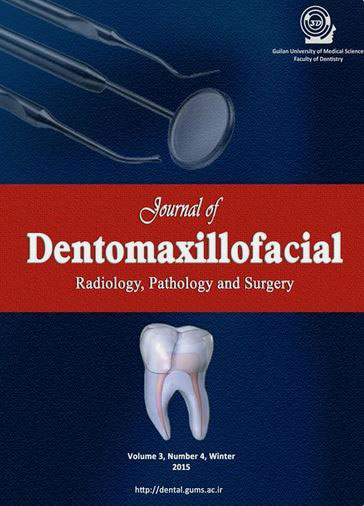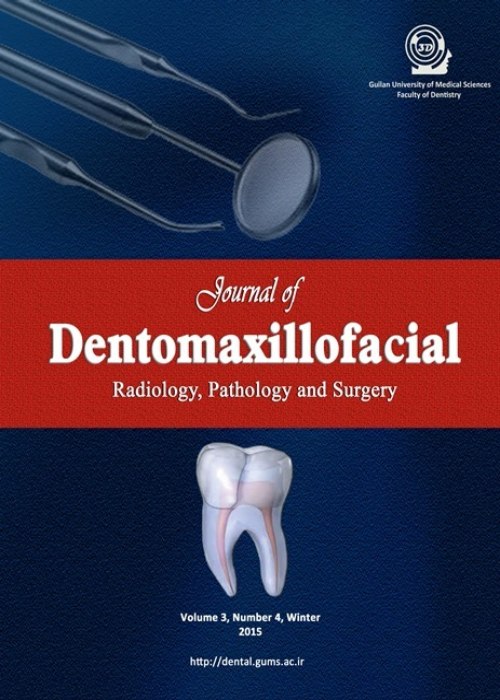فهرست مطالب

Journal of Dentomaxillofacil Radiology, Pathology and Surgery
Volume:7 Issue: 1, Spring 2018
- تاریخ انتشار: 1397/03/08
- تعداد عناوین: 7
-
-
Pages 1-6IntroductionWith increased usage of restorative materials, dentists are more concerned in choosing a suitable material with lower adhesion of pathogens like streptococci. This comparative in vitro study aimed to compare adhesion of streptococcus mutans to zirconia, IPS Empress II, noble alloy, and base-metal.Materials and MethodsIn this descriptive study, 50 specimens (5 mm diameter disk with 1 mm thickness) were prepared (10 for each material; zirconia, enamel, IPS Empress II, noble alloy, and base-metal). Enamel was used as reference. The specimens were covered by artificial saliva and bacterial suspension. Scanning electron microscope and culturing the specimens in blood agar was used for evaluating bacterial adhesion. The collected data were analyzed by ANOVA and post-hoc Tukey test.ResultsThere was a significant difference in adhesion among study groups (P<0.001). The least amount of adhesion was observed in zirconia group (28±6.32), followed by enamel (48.2±8.4), IPS Empress II (50.6±6.99), noble (76±4.9) and base-metal (106.4±9.44). There was no significant difference in surface roughness among study groups.ConclusionZirconia showed the lowest bacterial adhesion in comparison to other restorative materials. Therefore, the findings of the present study highlight the fact that restorative ceramics, including zirconia is a better choice in patients with poor oral hygiene and those susceptible to periodontal disease.Keywords: Bacterial adhesion, Streptococcus mutans, Restorative material
-
Pages 7-11IntroductionOrthodontic treatments and brackets application with various ligature methods have increased worldwide, but the growth rate and mechanism of microorganism adhesion to these ligatures is not fully discovered. The current study aimed to compare the level of streptococcus mutans adhesion to three different ligation methods.Materials and MethodsThis in vitro study was performed on 30 samples. Three different ligature methods were used and 10 samples were used in each group. In group A, conventional brackets with elastomeric ligature, in group B, conventional brackets with steel wire ligature and in group C, self-ligated brackets were used. Resin composite was condensed on the mesh surface of the brackets and cured for 40 seconds. Then, the coated samples with saliva were put into glass vials, immersed in 2 mL of streptococcus mutans suspension (×109 CFU) and incubated at 37ºC for 24 h. Then, the samples were washed 3 times with normal saline, immersed into 2 mL of normal saline and shaked for 2 min. The obtained suspension was cultured on blood agar incubated at 37ºC for 48 h and the formed colonies counted. In analysis, we performed 1-way analysis of variance with Tukey test with multiple comparison in SPSS version 16.ResultsAccording to the results, streptococcus mutans growth rate showed statistically significant differences in the three groups. It was minimum in the steel wire (23.80±1.40), and maximum in elastomeric ligatures (38.60±1.84).ConclusionSteel wire ligatures had better effect on decreasing bacterial adhesion. The findings high light to decrease the use of elastomeric ligation brackets in patients with poor oral hygiene.Keywords: Adhesiveness, Orthodontic bracket, Streptococcus mutans
-
Pages 13-22IntroductionBrackets and other fixed orthodontic appliances not only make tooth brushing more difficult, but also provide a suitable environment for the accumulation of plaque. To prevent this situation, dentists usually educate their patients to control the plaque formation and maintain good oral hygiene. This study aims to compare the effect of multimedia and practical education on the knowledge and practice of oral hygiene in patients with the fixed orthodontics appliances.Materials and MethodsIn this educational trial study, based on inclusion criteria, 60 patients aged 12-35 years with orthodontic brackets bonded to their upper jaw teeth for less than 6 months were consecutively selected from referrals to the specialty dental clinic of the International Branch of Guilan University of Medical Sciences. The samples were randomly divided in two groups of 30 subjects: practical education group and multimedia education group. Plaque and gingival indices and knowledge of the patients before and 2 months after the training were compared. To compare the knowledge score, gingival index and plaque index before and after the training and also to compare the changes in these variables in the two groups, t-test analysis was performed.ResultsThe knowledge level, the gingival index and plaque index of both educational groups improved after education compared to before the education (P<0.001). There was no significant difference between two groups with regard to changes in the variables of knowledge level (P=0.823), plaque index (P=0.66), and gingival index (P=0.292).ConclusionBoth educational methods improved the hygiene and the awareness of the dental practice. Therefore, learning by a validated multimedia in the presence of an expert to answer the questions is as effective as the practical approach for the oral health and hygiene of orthodontic patients.Keywords: Oral hygiene, Orthodontic patient, Multimedia education, Practical education
-
Pages 23-28IntroductionTemporomandibular joint disorder (TMD) is one the most common maxillofacial disorders and its prevalence has been reported variously in different populations. This study aimed to assess the prevalence of symptoms of TMD in dental students of Post Basic Science course, Faculty of Dentistry, Guilan University of Medical Sciences.Materials and MethodsThis descriptive cross-sectional study was carried on 120 dental students (from 140 students) who participated and answered the questions of this study in 2016. Demographic data of dental students were collected and all subjects were clinically examined. The diagnosis of TMD was confirmed on the basis of its signs and symptoms, including click, pain, or tenderness of masticatory muscle, jaw deviation during mouth opening and limited mouth opening. The prevalence of TMD in subjects was assessed with respect to age, gender, marital status, parafunctional habits, history of trauma, and nutritional status. The obtained data were analyzed by SPSS 21 (P<0.05).ResultsThe sample consisted of 120 subjects, 55 (45.8%) women and 65 (54.2%) men. The prevalence of TMD was found as 28%, which had a relationship with parafunctional habits, muscle tenderness, tooth wear, jaw dislocation, trauma, temporomandibular joint pain, and in some symptoms with age. While it was not associated with factors such as gender, marital status, nutrition type, click, deviation, headache, migraine, earache, posterior tooth loss, and contact in balancing side.ConclusionTMD is a relatively common condition among dental students. By providing the necessary training for students, especially for those who are at risk (patients with parafunctional habits, tooth wear, jaw dislocation, trauma), we can prevent TMD.Keywords: Temporomandibular joint Disorders, Click, Parafunctional habits
-
Pages 29-35IntroductionIntegration of curriculum is currently performing in dental schools. Many factors such as proper and purposive planning, teachers’ experience and attitude, optimal condition and facilities in the context can impact the integration process. This research aimed to investigate knowledge and attitude of dentistry faculty members towards integrated curriculum and its related factors.Materials and MethodsIn this descriptive cross-sectional study, knowledge and attitude of 51 faculty members of Guilan Dental School were assessed through a researcher-made questionnaire in 2016. Knowledge and attitude parts were assessed by 8 and 18 questions, respectively. Wrong answer to each question of knowledge part scores 0 and the right answer 1. In calculation of attitude score, score of 5 was given to complete agreement, 4 to agreement, 3 to no opinion, 2 to disagreement, and 1 to complete disagreement. The validity of questionnaire was confirmed through content validity test [Content Validity Index (CVI)=0.8, Content Validity Ratio (CVR)=0.86)] and the reliability of questionnaire was examined by test-retest (r=0.8). The obtained data were analyzed by the Independent t-test, Mann-Whitney U, Pearson correlation, and Spearman rank tests in SPSS (version 20).ResultsFaculty members’ Mean±SD score in knowledge was 3.2±0.273. About 7.8% of the faculty members had high level of knowledge, 27.5% good level of knowledge and 43.1% moderate level of knowledge. About 64.7% of the faculty members had negative attitude towards integrated education, but 27.5% of members had positive attitude towards integrated education. There were not significant relationships between age, gender and work experience with knowledge scores and also attitude.ConclusionGiven the need for change in teaching methods, we hope to increase student’s problem-solving skills, and deep sustainable learning with creation and preparation of curriculum integration requirements.Keywords: Integration of education, Knowledge, Attitude, Dentistry, Curriculum
-
Pages 37-42IntroductionThere are few studies investigating the role of neoangiogenesis in biological behavior of salivary gland tumors. CD105 expression has demonstrated greater accuracy for detecting new vessel formation compared with other pan-endothelial molecules. This study aimed to assess and compare intratumoral Micro-Vessel Density (MVD) through using immunohistochemichal expression of CD105 biomarker in Mucoepidermoid Carcinoma (MEC), Adenoid Cystic Carcinoma (AdCC) and Pleomorphic Adenoma (PA).Materials and MethodsCD105 expression using Immunohistochemistry (IHC) was assessed in 20 cases of PA, 20 cases of AdCC, 20 cases of MEC, and 10 cases of normal salivary gland tissues. Positive intratumoral micro-vessels for CD105 expression were measured quantitatively for the assessment of Micro-Vessel Density (MVD) in each group. Groups differences in MVD was analyzed statistically using the Mann-Whitney U test and Kruskal-Wallis test. One-way ANOVA and post hoc Tukey test were also carried out. P values less than 0.05 were considered statistically significant.ResultsCD105 positive vessels were rarely seen in normal salivary gland tissue. Statistically significant differences in MVD were observed between the normal salivary gland tissue and AdCC and also MEC (P<0.017 and P<0.001, respectively). There was a statistically significant difference in MVD between PA and AdCC and also MEC (P<0.018 and P<0.001, respectively). MVD was higher in MEC in comparison with AdCC (P<0.002).ConclusionThe results of the current study demonstrated higher neoangiogenesis in AdCC and MEC by measuring CD105 expression, which suggests a possible role for this phenomenon in aggressive behavior of these malignant salivary gland tumors.Keywords: Endoglin, Pathologic neovascularization, Salivary gland neoplasms
-
Pages 43-50IntroductionResearchers have always been interested in the close and mutual relationship between the pulp and periodontal tissues. Although the effects of pulpal disease on periodontium have been well known, the clear relationship between periodontitis and pulp has not been documented . It seems that bacteria and inflammatory products of periodontitis can affect pulp through accessory canals, apical foramen, and dentinal tubule. Meanwhile, Vascular Endothelial Growth Factor (VEGF) and Nerve Growth Factor (NGF) are components of growth factors which increase in the inflammatory tissues. This study aimed to evaluate periodontal disease effects on the expression of VEGF and NGF in dental pulp.Materials and MethodsIn this analytical cross-sectional study, 30 human dental pulp specimens were collected from 15 teeth with severe chronic periodontitis and 15 teeth with healthy periodontium. The percentage of stained cells (LI) and intensity of stained cells (VEGF and NGF) were calculated and compared between two groups by Independent t test and Fisher analysis.ResultsThe percentage of stained cells for VEGF in the case group was 34.514 and in the control group 35.473. The percentage of stained cells for NGF in the case group was 34.962 and in the control group 34.592. There was no statistically significant difference between two groups (P>0.05). In addition, there was no significant and qualitative difference between the case and control groups with regard to the intensity of stained cells (P>0.05).ConclusionAccording to the results of this study, severe periodontitis did not affect the expression of the VEGF and NGF in dental pulp.Keywords: Immunohistochemistry, Vascular Endothelial Growth Factor (VEGF), Nerve Growth Factor (NGF), Severe periodontitis, Dental Pulp


